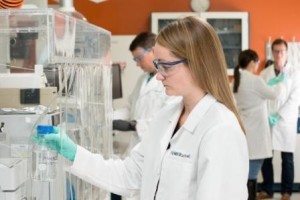We’ll never argue that science is simple. In fact, parts of it are so complex that even the experts can find themselves at a loss as to how to use tried-and-true scientific measures to answer a burning question. That’s often the case with HPLC (high-performance liquid chromatography) of polymers.
HPLC is an immensely helpful type of chemical testing that scientists often use to separate components in a mixture, identify what they are, and determine how much of each is present in a solution. The testing involves pumping a pressurized liquid solvent that contains the sample liquid through a column filled with a solid, adsorbent material. The atoms, ions or molecules of each component in the sample solution will interact differently with the adsorbent, ultimately causing the components to separate as they flow out of the column. Once separated, we can identify and measure the components.
separate components in a mixture, identify what they are, and determine how much of each is present in a solution. The testing involves pumping a pressurized liquid solvent that contains the sample liquid through a column filled with a solid, adsorbent material. The atoms, ions or molecules of each component in the sample solution will interact differently with the adsorbent, ultimately causing the components to separate as they flow out of the column. Once separated, we can identify and measure the components.
Pretty nifty, eh? Except HPLC works best with small molecules, and as we know, your typical polymer molecule is anything but small.
HPLC anaylsis of polymers (other than proteins) is rare and very challenging,” says Jason Todd, our chromatography lab manager and expert. “The choice of solvents that can dissolve a polymer is typically very limited, compared to small molecules, and limits the type of HPLC method you can use. Also, polymers contain a distribution of chain lengths, which often will result in multiple peaks or a very broad peak during the HPLC separation. We need a single, fairly narrow peak to quantify the amount of each polymer that is present. Achieving a single, narrow peak for each polymer requires a lot of method development in terms of finding the right HPLC column and mobile phase solvents.”
Recently, Polymer Solutions took on a job that had stymied two other labs. The client asked PSI to quantify preservative compounds (parabens) present in a water-based cleanser that contained a polymer. In initial tests, the polymer didn’t behave as anticipated and some of the preservative compounds weren’t very water-soluble, so they didn’t respond well in HPLC testing.
After discussing with the client performance requirements and what previous testing other labs had tried, PSI’s team gathered information on the composition of the test sample and the properties of the polymers, including molecular weight, chemical composition and solubility. A literature review turned up useful testing information for one of the polymers, but nothing on the other.
“At the time we were beginning the method development, I was fortunate enough to be attending a technical conference dealing with polymer analysis, and I was able to gain valuable insight by attending presentations and talking with leading experts in the field of polymer HPLC separations,” Jason says.
Our team used orthogonal HPLC methods to perform initial screening experiments. We chose one HPLC method for further development, based on its initial performance in separating the target polymers. We refined the method parameters until we could achieve optimal results from the testing. We also developed a method for sample and standard preparation, and did accuracy and precision studies to verify the method we’d developed would be suitable for its intended use.
“This example is typical of our process for method development,” Jason says. “We start by identifying the client’s objective (quantify preservative compounds present in an aqueous cleanser formulation) and any known constraints (such as available sample amount) and potential issues (a polymer is present, which could interfere with the analysis). We then choose an appropriate analytical method (HPLC, GC, etc.) based on the physical properties (volatility, UV absorbance) and expected concentration range of the targeted analytes. We use our knowledge of polymer solubility to identify appropriate solvents and extraction techniques. We then proceed with the method development, using our knowledge and experience to deal with any issues that are encountered along the way.
“Our goal is to end up with a method that is suitable for its intended use, in terms of being able to measure the concentrations of the target compounds with acceptable accuracy and precision.”
